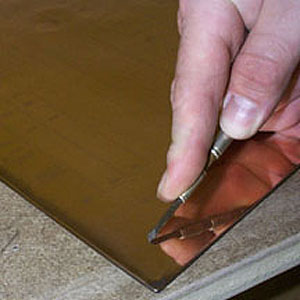





Page
Etching
and colouring
The Collection
Distributors
Learn about Engraving and Intaglio
In the world of printing and print making, almost all methods fall under one of 3 basic headings, Relief, Planographic and Intaglio. The latter method, as employed at Thomas Ross, is described here. Intaglio is the collective term for the the print making techniques that encompass engraving and etching. It's distinction and the feature responsible for such "depth of tone" is that the image on the plate is formed by lines and crevices cut below the surface rather than by an image raised above the rest of the printing plate (as in relief) or by different surface properties (as in planographic)
ENGRAVING
Engraving as a printmaking method was developed during the 15th Century when metal plates began to replace the use of carved wooden printing blocks for the reproduction of works of art. A plate of soft metal is used, most often copper, and the design engraved (cut into) into the surface using a tool called a "burin" which is a square tool-steel rod, sharpened diagonally at one end, such that the prominent corner becomes an effective and controllable cutting edge.
The highly skilled engraver uses the burin to cut an image, as a series of lines of varying width and depth, that are a translation of the tones and shadings of the artists original work. Deep lines hold more ink than shallow ones, producing a darker tone when printed.
The degree of faithfulness with which the engraving can represent the original image from a quite different medium, such as an oil painting, is remarkable, and a testament to the engravers own art.
The richness of inking in intaglio prints sets this method apart from other printmaking techniques.
(Right) Using a burin to engrave a copper plate

While copper is in many ways an ideal metal for engraving, it's softness which enables it to be cut with reasonable freedom, is a disadvantage, when it comes to printing from the finished plate. At this stage, the softness of the metal, means that the image is vulnerable to rapid wear from the wiping which is an integral part of intaglio printing. For this reason, during a period in the history of intaglio printmaking, many engravings were produced on steel rather than copper plates, which are much more durable by virtue of greater hardness of the metal. This hardness however, makes the task of the engraver very much more difficult, and restricts his style, by reducing his "freedom of expression" The problem of rapid wear of copper engravings, together with the difficulty of engraving on steel, was solved in the late 1850's with the invention in France of the process of "steel facing". This revolutionary technique, a special form of the then new discovery of electro-plating, enables a very thin "skin" of steel (less than two ten-thousands of an inch) to be applied to an engraved or etched copper plate, imparting the hardness of steel to the engravers favourite metal of choice. Since it's invention, some one hundred and forty years ago, most engraved plates have been made on copper, and steel faced for protection from wear. Steel facing is used to this day at Thomas Ross, and is an essential part of preserving valuable copper plates, while still enabling them to be printed for all to enjoy.
ETCHING
This method shares many similarities with engraving, in so far as the aim is to produce crevises and lines below the surface of a metal plate (also usually copper)
The key difference from engraving, is the use of acid to actually remove the metal, rather than to cut into the surface with a tool. The most basic form of etching, commences with a layer of wax (known in etching as a "ground"), which is resistant to the acids used, being applied to the cleaned surface of a flat metal plate. The desired image is then drawn through the wax using a pointed metal tool called an "etchers needle" so that the surface of the metal is exposed through gaps in the wax. Once the drawing is complete, acid is applied to the surface and it "bites" into the plate guided by the lines drawn through the wax, producing lines and crevices that correspond to the image drawn. By repeated masking of selected areas of the image, using a painted-on lacquer or varnish, followed by re-applying the acid, lines of different depth, and hence tone can be created to build up the final result.
Because the etcher has only to draw the design through wax, rather than wield a tool with sufficient force to cut into metal, it is possible for the work to "flow" much more easily than with engraving. The easy strokes of the needle, and the softness of line resulting from the work of acid, go together to produce an appearance and tone in the finished print that bears resemblance to a fine pencil drawing. This technique just described, called hard ground etching, is perhaps the most elementary form of etching. Over the years however, a number of other ways of using acid to etch a plate have developed.
Shown (right) An enlarged illustration of an aquatint ground . . .
Other etching techniques include aquatint (which produces a speckled tone sometimes said to resemble water-colour washes), soft ground etching, (photo)gravure etching (not to be confused with relief photo etch) and sugar-lift etching. Very often, intaglio plates are made using a number of techniques combined together to produce the effect that is desired. Sometimes engraving methods may be used to finish a design and add additional detail in combination with etching techniques to create the basic image.
Printing from the finished plate, uses the same methods, whether the plate has been made by etching or by engraving. Follow the link to the Hand Printing and Colouring page to find out more . . .